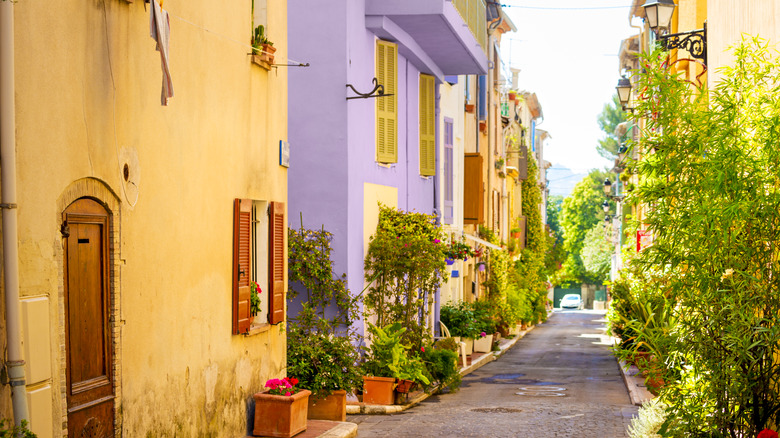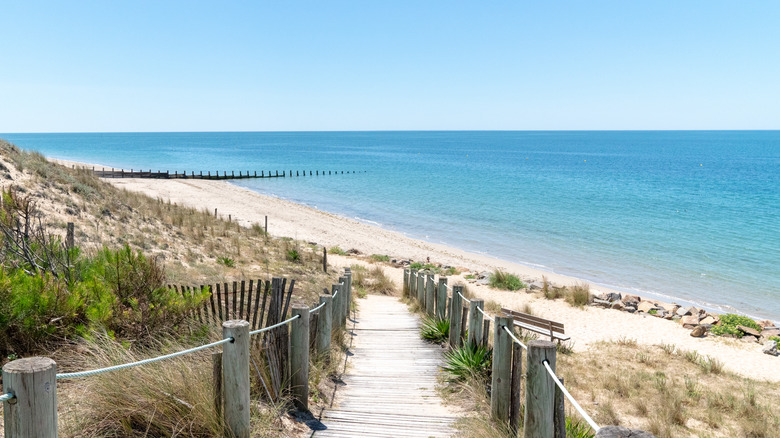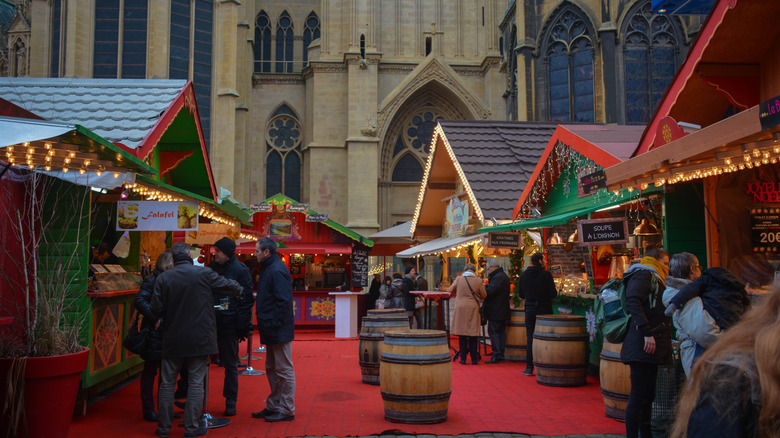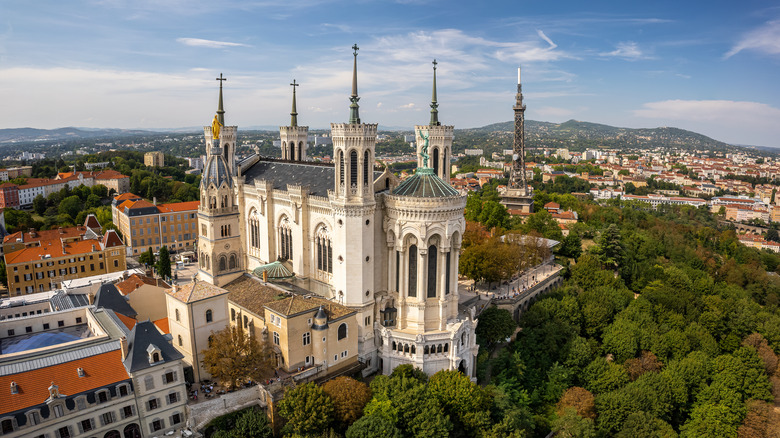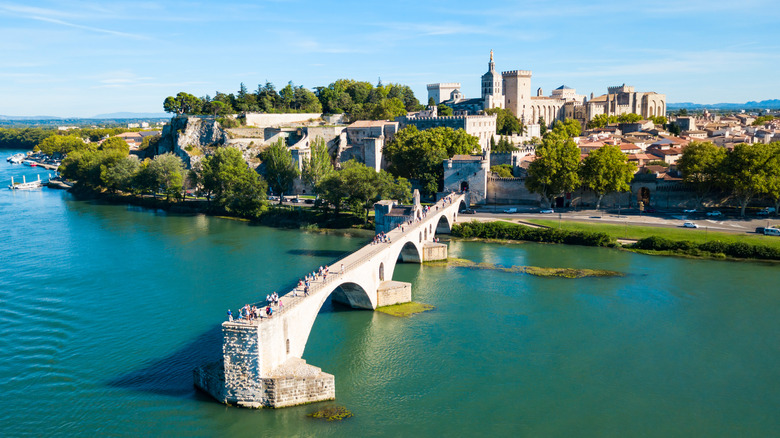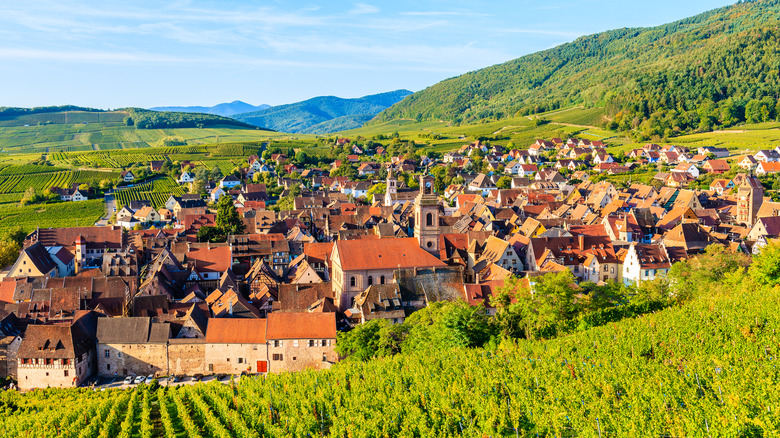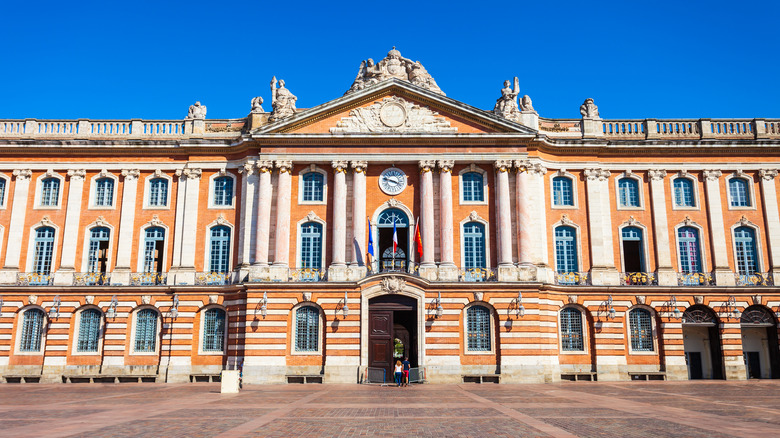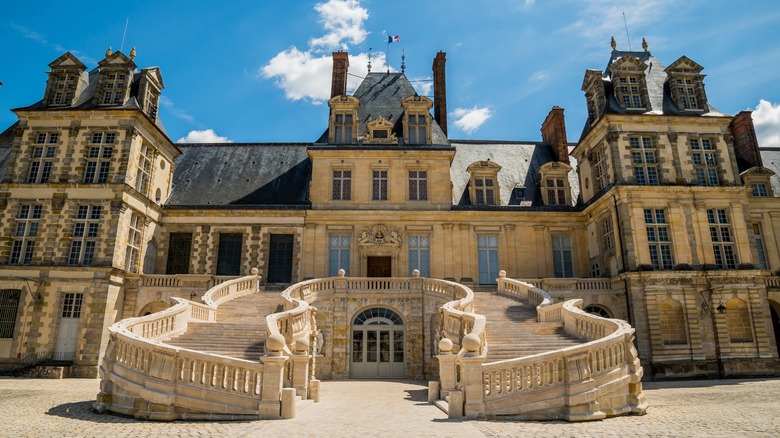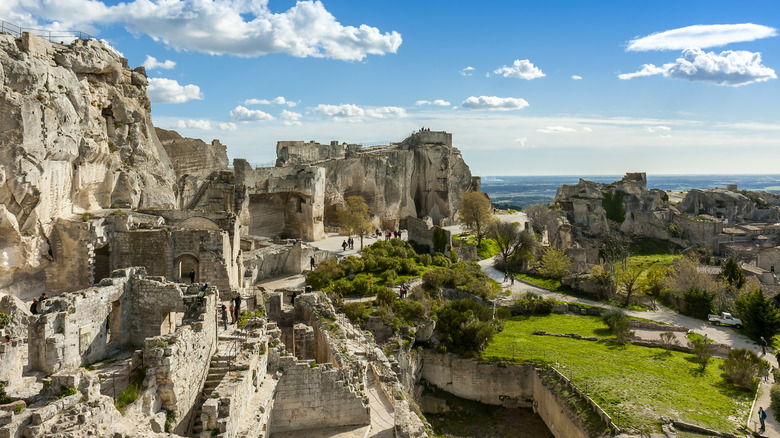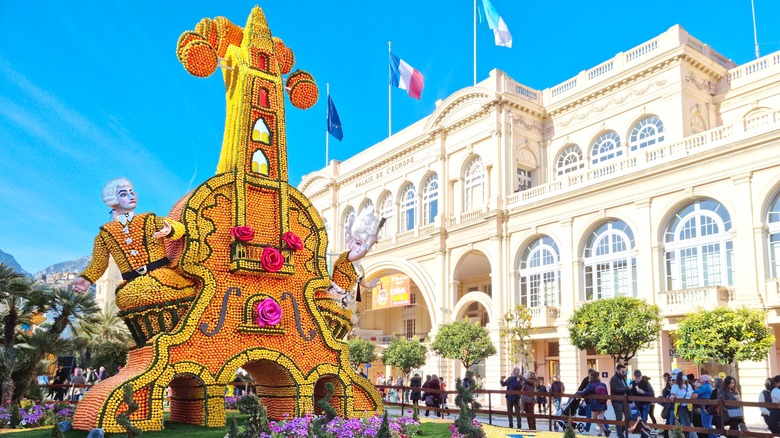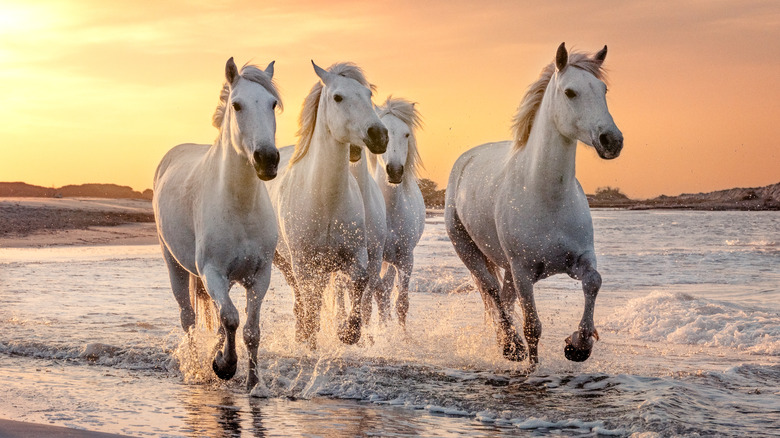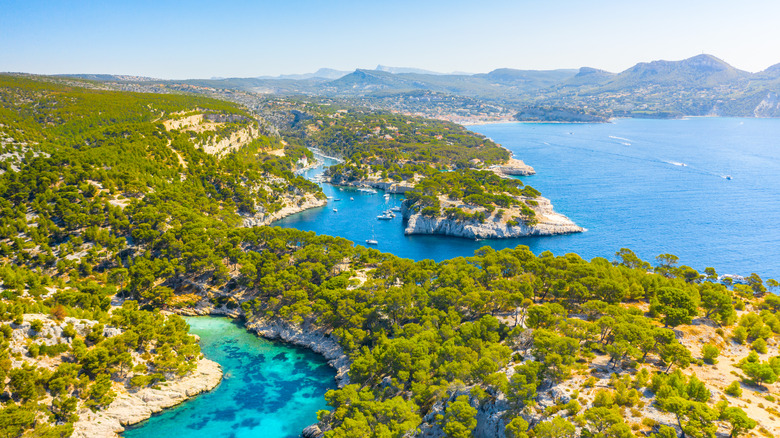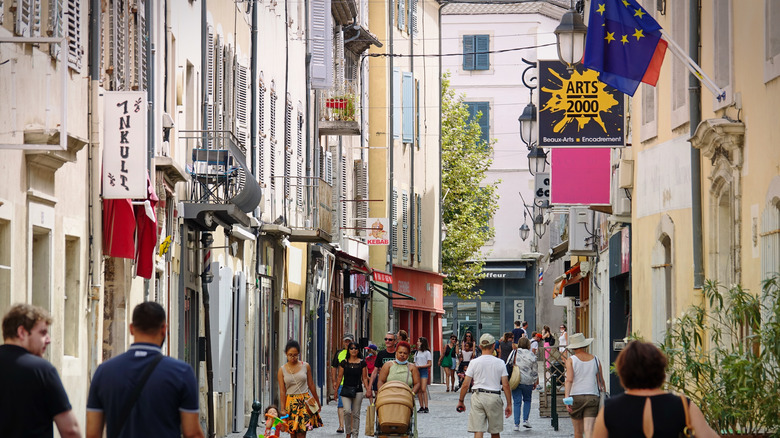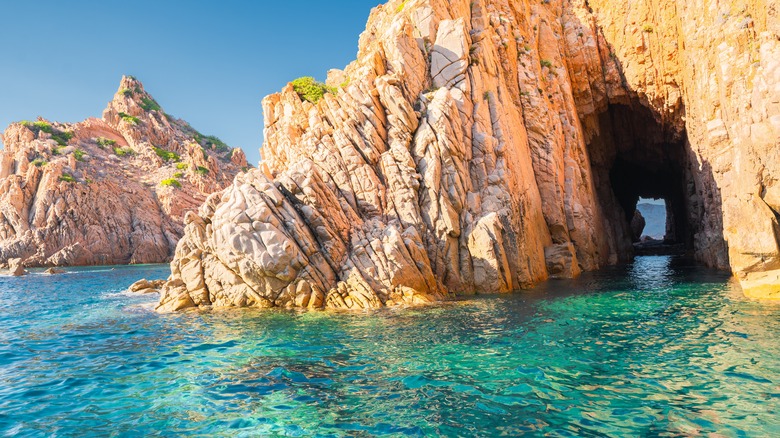Underrated Tourist Destinations To Visit On Your Next Trip To France
France has been the most visited country in the world for decades now, so if you want to avoid the crowds it's best to check out the more underrated tourist destinations. Luckily, despite being about the same size as some U.S. states, France is diverse in landscape, cities, food, and sites.
You have a bounty of options when it comes to planning your trip. This can be intimidating, which is why it's easy to fall into the pattern of flying into Paris, taking a few day trips, and maybe visiting one other major city. However, if it isn't your first visit, one of the best things you can do is expand your itinerary. There is so much to offer in this beautiful part of the world! From the ocean to the mountains, towns small and large — and everything in between. Here are some top recommendations of off-the-beaten-path places to visit in France.
The Beaches of Bretagne
Everyone pictures the South of France and especially the Cote d'Azur for beach vacations in France. But those in the know head north. The shores of Bretagne, or Brittany in English are actually home to the best beaches in France, even if they aren't as mythical or home to a popular film festival like their Mediterranean counterparts. Unlike those down south, which are primarily pebble or rock beaches (and thus require water footwear or hardy feet), the northwest is all white sand and turquoise waters whose shades change in the sunlight. And while towns like Rennes and Le Havre are popular getaways with Parisiens, you likely won't meet too many fellow international travelers. If you want to ensure even fewer crowds, rent a car and drive to quaint and sleepy villages like Dinan, Saint-Malo, and Brest.
The beaches are what you come for but Breton cuisine is why you'll stay. From the best moules frites (mussels and fries) on the coast to the unique savory crepes made exclusively with buckwheat called Gallete Bretonne and amazing cider, you'll leave with a whole new favorite regional cuisine. Direct trains to Rennes, St-Malo, and Le Havre leave Paris Montparnasse station daily. The journey from Paris by train lasts 1.5 to 2 hours, depending on the final destination.
Metz Christmas Markets and Mirabelle Festival
Strasbourg might be the most famous city for markets during the holiday season, but Metz is the best-kept secret if you want fewer crowds and an equally adorable city. Sure, Alsace has all the French-German history that gives it a year-round Christmas vibe, but Lorraine (where Metz is located) is special in its own way. The compact city center hosts impressive Christmas Markets every year from late November until the 25th of December. You'll find an ice rink at Place de la République, a large Ferris wheel (that rivals the one in Paris in December) at Place d'Armes, and numerous food vendors at Place de Chambre and Place Saint-Louis. And Metz is only an hour and a half high-speed train ride away from Strasbourg, so you could easily combine the two on a Christmas Market trip.
Then, in summer return to the northeast's cutest city and check out the Mirabelle Festival. This celebration of plums (popular throughout the region) runs for a few weeks every August and is an absolute delight. Enjoy activities like parades, shows, and markets with samples, all dedicated to this delicious purple fruit. Additionally, since late summer is when most of northern Europe flocks to the beaches, you'll enjoy fewer crowds in this already-under-the-radar town. Metz is just under 2 hours by train from Paris and just under an hour from Luxembourg City.
The Lyon Basilica
Paris' Notre Dame might be the most famous church in the country but Lyon's Basilica Notre-Dame de Fourvièreis much less crowded and has a better view. Built in the late 1800s, the church is a kaleidoscope of colorful mosaics, stained glass, and icons. You might need to visit the chiropractor or a yoga class after craning your neck to examine every square inch of this magnificent structure. However, the best part isn't the interior (a rarity for European churches) but the outside, where you are rewarded with the most stunning panoramic views in all of Lyon. There is no entrance fee.
If you fancy a bit of exercise and love discovering different views from various vantage points around cities, walk up the hill from the Old Town to reach the basilica. Fouvière Hill was the original center of the city when it was founded back in 43 BC by the Romans. While the Lyon center has now migrated south to the islands and banks of the Saône River, the mini-peak is still well-populated by homes, walking paths, parks, and of course the church. Different paths and stairways from the lower city are well-signposted up to the basilica. Alternatively, you can take the metro D-line to Vieux-Lyon and transfer to the funicular. The gardens just below the building make for a nice walk back down to the city, there is also an archeological site nearby.
Avignon Old City and Saint Bénézet Bridge
"Sur le Pont d'Avignon" is a popular French song about this famous bridge whose existence is truly a miracle. Due to a very strong current in the Rhône River and frequent flooding, a bridge across the water proved difficult to construct for centuries. The Saint Bénézet bridge initially opened in 1185 and consisted of 22 arches. After a battle in 1226 that destroyed most of the Passerelle, residents pulled money and resources together to reconstruct the bridge. However, maintenance proved expensive and difficult, so after centuries of flooding and battering by the weather, the city of Avignon decided to abandon what was left of the structure. Today, only four arches remain, along with a small museum.
The entry fee is only 5 euros, however, you can buy a combination ticket for the bridge and Popes' Palace or for the palace, bridge, and gardens. You'll access Saint Bénézet through Avignon's Old City anyways so the multi-site passes are definitely worth a few extra euros. And nearby Arles, Nimes, and Montpellier make great additions to an itinerary if you'll be in the area.
Alsace Wine Country
Bordeaux, Champagne, and Burgundy might be the most famous wine regions in France, but if you're looking for something a bit different, head to Alsace. The area is best known as a fantastic Christmas destination, but its' climate and topography also mean certain grapes thrive here. Similar to Germany (which occupied the region in WWII), Alsace primarily produces white wine due to the location and weather. The main varietals are Riesling, Pinot Gris, Pinot Blanc, and Gewürztraminer. However, don't avoid the Riesling even if it's not usually your cup of tea (er — glass of wine.) Alsace's version is much drier than the sweet white wine that is usually associated with the varietal. You might find you enjoy Riesling quite a bit here.
The crémant made in the region is a sparkling white wine comprised of a blend of the different grapes grown in the area. It makes for a nice, budget-conscious alternative to champagne and many people prefer it to its bougier cousin. The only red really produced in Alsace is Pinot Noir which also makes up 100% of the Rosé. The best way to visit the wineries is to fly or take the train to Strasbourg and rent a car. Alternatively, numerous companies run wine-tasting tours, including active ones via bike in the summer months. And of course, you'll find Alsacien wine on every restaurant and bar menu in the region.
Toulouse
Toulouse is known as "La Ville Rose" or "The Pink City" because pink bricks are used for most buildings in the city center. This gives the town a unique look that is best enjoyed at sunset or golden hour as the light bathes the rose-colored material beautifully, a photographer's dream. The best place to enjoy the light and snap amazing pics are Place du Capitole, in front of the town hall and the old mansion that is the Bemberg Foundation. Additionally, if you find yourself along the banks of the Garonne, the sunset is especially spectacular.
The city is also home to numerous churches and gardens that are free to wander into and if you're lucky you might pass by an old manor with an open door that allows you to peer in. On the banks of the Garonne River, you can take a river cruise that is arguably better (and cheaper) than those along the Seine, and check out the Canal du Midi, a UNESCO World Heritage Site. Toulouse is a one-hour high-speed train ride from Bordeaux or a four to six-hour journey from Paris.
Palace Fontainebleau
Versailles is the most popular day trip from Paris as well as the most famous palace in France, and while it is certainly beautiful, you should consider alternatives. This is particularly true during peak season and Fontainebleau is the perfect solution! Napoleon's former imperial palace is located just 40 minutes from the capital city by train and is a great place to spend the day. It is by far less crowded than its' more-frequented neighbor, is no less beautiful and since it wasn't raided during the Revolution, there are actually more treasures inside than in Versailles.
In fact, the Château de Fontainebleau is known as the "most furnished" castle in France due to the volume still inside the building. There are also often art exhibitions and concerts held at the chateau. It is open most days besides major holidays like January 1st, December 25th, and May 1st. Admission costs 14 euros, but the surrounding parks and gardens can be visited at no charge.
Les Baux de Provence
This UNESCO World Heritage site is an old medieval village that sits upon a hill inland from the Mediterranean. The centuries-old walls still surround the town which is listed as one of the most beautiful in all of France. Follow winding cobblestone alleys through grey-washed stone buildings with vibrant blue shutters and shops that can be touristy, but still maintain small-town charm. One of the best parts is the elevated location which provides sweeping views of the surrounding French countryside.
Beyond strolling the streets, make sure to visit the Chateau de Baux, long destroyed but the ruins make for an interesting walk. It cost 6 euros to visit. Additionally, the Carrières de Lumières is a great little art gallery with mind-boggling light shows and installations. Admission is 14.50 euros. And while Les Baux de Provence certainly receives visitors, It is definitely a quieter, different side of Provence than most people experience. It is located about a 30-minute drive from Arles or an hour bus ride.
Menton Lemon Festival
Menton is a wonderful little town in the south to spend a few days and you won't experience the crowds of nearby Nice and Cannes. Like most of southern France and Italy, lemons grow in abundance in the area around Menton. And every year from mid-February to early March, the city comes alive in yellow colors and citrus flavors during the annual Fête du Citron or Lemon Festival. Back in 1928, the city boasted the title of the top lemon-growing region in all of Europe and a hotelier had an idea to build an event around the popular fruit and ingredient. Then in 1934, the municipality held the first official festival which has taken place ever since!
Parades of lemon-themed floats and performers take place throughout the day and night. And the street is full of lemon-themed art exhibitions and crafts fairs. You'll need to purchase tickets to the parades ahead of time, but all other events are free to attend. Menton is located on the French Riviera, right next door to Italy, and about a 35-minute train ride from Nice.
The Camargue Horse
The Camargue region in the south of France is located along the coast, between the Mediterranean and the Rhône River. It is home to stunning scenery, from wetlands to dunes and salt flats, there's a bit of everything. Additionally, the wildlife is quite different from the rest of France, flamingoes fly overhead, long-horned cows wander the marsh, and the famous Camargue horse gallops mostly free. The small white breed hasn't changed much from ancient times as depicted in cave paintings and it is considered one of the oldest in the world. You can even ride one in the Camargue Regional Nature Park. Additionally, if you fancy a longer holiday, numerous ranches offer vacation packages not unlike Dude Ranches in the West of the U.S.
The main towns in the Camargue are Saintes-Maries-de-la-Mer and Arles. Both are located about an hour to an hour-and-a-half from Montpellier and Marseille by train. Although you'll likely want a rental car to explore the area and visit the ranches. Saintes-Maries-de-la-Mer also hosts the annual Féria du Cheval every July, a festival dedicated to the region's special horse.
The Calanques
The Calanques National Park is located just a short bus, car, or bike ride away from Marseille, Cassis, and La Ciotat in southern France. It is known as a unique retreat in the country as it is the only one in the country that consists of the sea, land, and cities (technically the aforementioned urban areas are a part of the park.) "Calanque" in French roughly translates to "cove" or where the ocean cuts into the land. Thus, the national park is a series of small calanques along the Mediterranean. The beauty of the area makes it high in demand amongst holiday-goers and there is a bit of something for everyone.
You can hike inland or along the water and even into the park from Cassis via the Calanques de Cassis route which follows the coast all the way to the Port Pin beach. Additionally, another popular trek is the Calanque de Callelongue which ends at a shallow swimming beach perfect for kids. If you prefer water activities, you're in luck, boat tours run daily from Cassis in the summer or alternatively, you can rent kayaks for a guided or self-guided tour of the coastline. The clear calanques are also perfect for diving should you want to spend your visit underwater.
Montélimar
The best base for travelers who don't want to choose between the Alps and the South of France, the nature around this small town is a haven for outdoor lovers of all types. You can hike, bike, or just enjoy the year-round sunshine. However, the real draw is the sweets. As the birthplace of nougat, you'll have the opportunity to sample some unlike anything else you've ever tried. In the 17th century, the almond trees that now surround the area were planted in and around town. At some point, someone got the idea to combine it with honey and other ingredients to create the now-famous sweet made from sugar, egg whites, almonds, honey, and often pistachio or vanilla flavors as well. Even if you're not usually a fan of the treat, you have to try it while visiting — you might just change your mind.
Today, you can visit confectionaries and museums to learn more about the town's famous sugary delight. Additionally, the main square is home to many cafes, restaurants, and art deco buildings that make for a nice feast for the eyes along with your desserts. The Palais des Bonbons du Nougat, is home to the old arcade, most of the museums, and numerous places to sample sweets. Montélimar is about an hour and forty minutes from Lyon by train or just under an hour from Avignon.
Corsica
This island next to Italy is set to become the next big destination in France. The beaches are some of the least crowded in Europe, with green-blue water and many of its' own "calanques" that are also nice for diving, it's a wonder this Mediterranean gem has flown mostly under the radar for so long. Corsica is also a trekkers', cyclists', and horse riders' dream with many routes crisscrossing the island and numerous top destinations accessible by means other than a car.
Hilltop villages such as Pigna and La Balagne make for spectacular views over the ocean. Additionally, the wine and cuisine of Corsica are unique to France, thanks to the island's isolation over centuries from the mainland. A plane is the easiest mode of arrival, with many carriers, including Air Corsica serving the island from cities across the continent. If you prefer not to fly, ferries run from French and Italian ports year-round.
